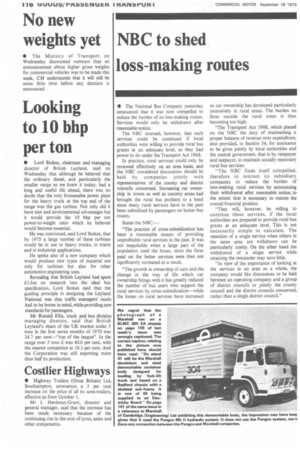Looking to 10 bhp per ton
Page 118

If you've noticed an error in this article please click here to report it so we can fix it.
• Lord Stokes, chairman and managing director of British Leyland, said on Wednesday that although he believed that the ordinary diesel, and particularly the smaller range as we knew it today, had a long and useful life ahead, there was no doubt that the only foreseeable power plant for the heavy truck at the top end of the range was the gas turbine. Not only did it have size and environmental advantages but it would provide the 10 bhp per ton power-to-weight ratio which he believed would become essential_ He was convinced, said Lord Stokes, that by 1975 a large number of these turbines would be in use in heavy trucks, in trains and in industrial applications.
He spoke also of a new company which would produce new types of material not only for turbines but also for other automotive engineering uses.
Revealing that British Leyland had spent E 1.6m on research into the ideal bus specification, Lord Stokes said that the guiding principle in designing the Leyland National was that traffic managers' needs had to be borne in mind, while providing new standards for passengers.
Mr Ronald Ellis, truck and bus division managing director, said that British Leyland's share of the UK market under 5 tons in the first seven months of 1970 was 34.7 per cent—"top of the league". In the range over 5 tons it was 40.6 per cent, with the nearest competitor at 16.1 per cent. And the Corporation was still exporting more than half its production.






























































































































































































































































































































































































